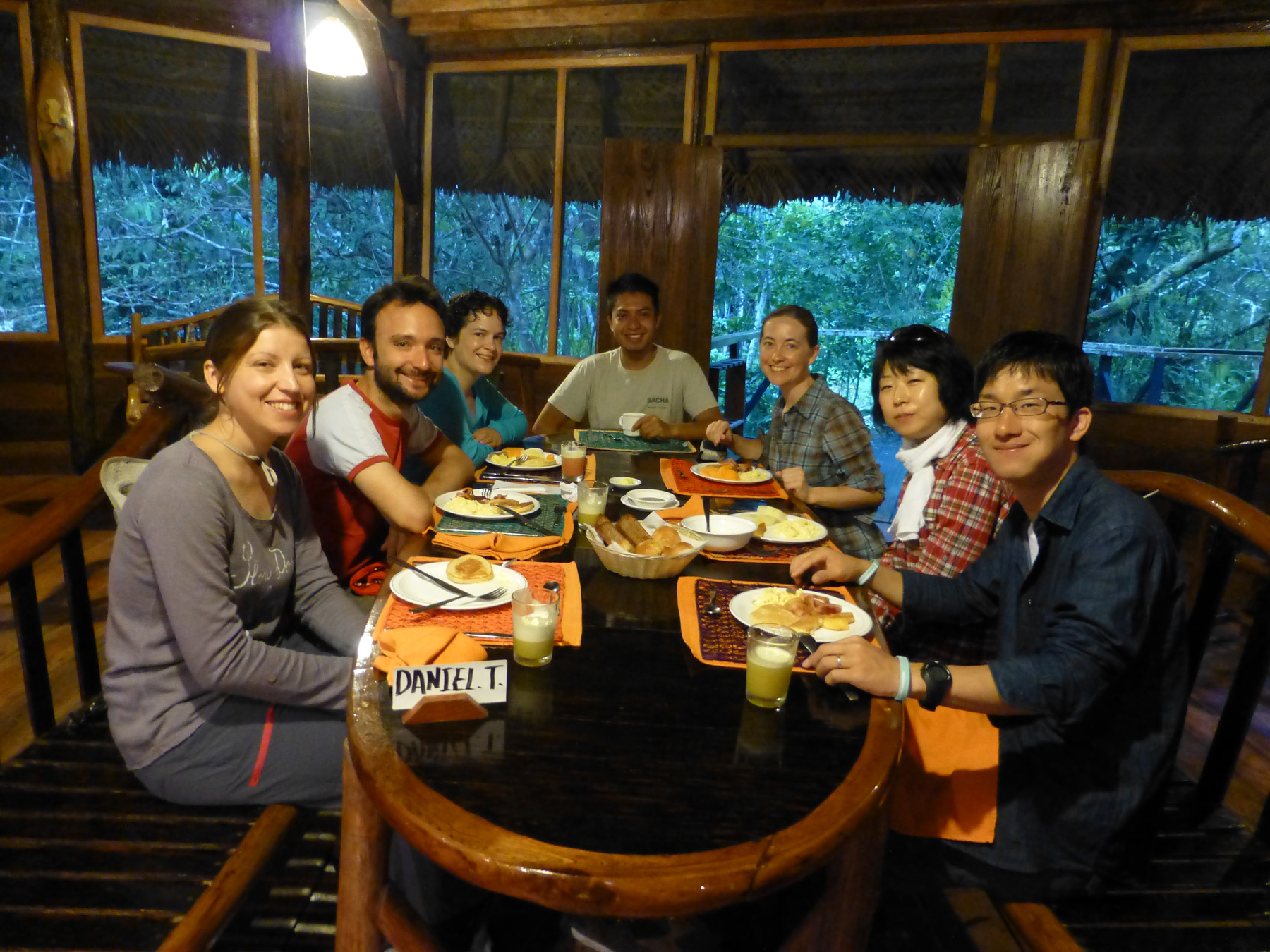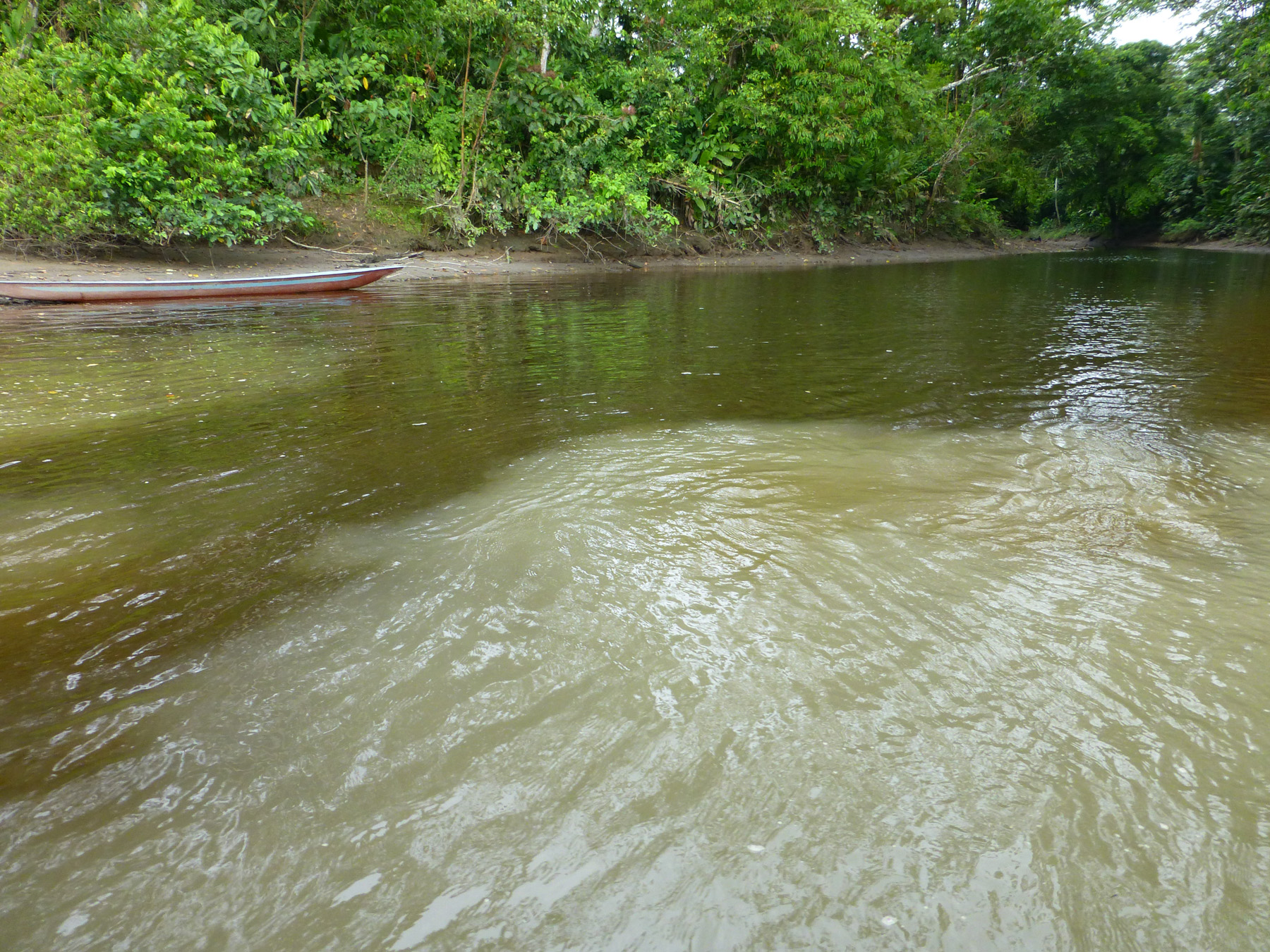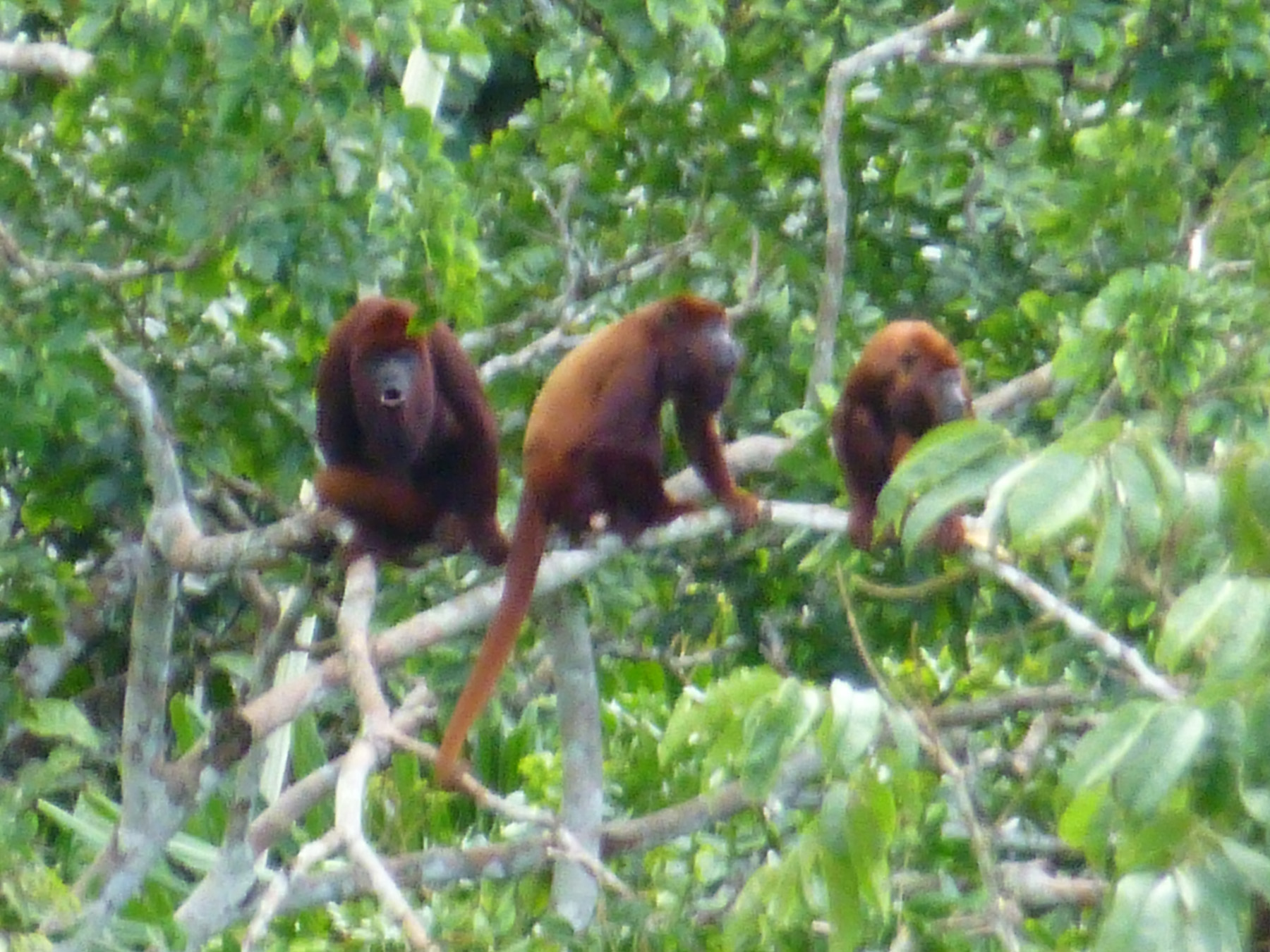Sept 15, 2013 - Sacha Lodge, Ecuadorian Amazon Rainforest
The previous day was unbeatable, as far as I was concerned. What could top dozens of tropical birds, chatting with tamarin monkeys, and discovering hairy tarantulas? Our experiences seemed impossible to improve upon, and our first activity of the day supported my theory.
We woke up early again and hiked back to the Napo River. Once there, we climbed aboard a motorized canoe and traveled downstream to a nearby “clay lick.” This was a favorite spot for parrots. Parrots aren’t picky when it comes to food. They eat any seed or fruit they can find in the jungle, and many of these can carry toxins. That is why they lick the clay. It acts as a neutralizer for the toxins, allowing the parrots to digest everything they eat and not get sick.
That morning, under an overcast sky, we floated offshore awaiting the parrots’ arrival. Other boats filled with tourists sat idle with us. The river doesn’t belong to any one group or person, so anyone can wait here and view the parrots. This was the first time since joining Sacha that I felt like a typical tourist; sitting with hoards of other foreigners, cameras in hand, hoping that the parrots would make their landing.
We could hear flocks of parrots in the trees above squawking up a storm. They were darting around and blending into the leaves, making them difficult to see at such a great distance. After loitering for a while, our boat driver decided to go further upstream to see if we could find other wildlife. Maybe the parrots will have made their move by the time we returned?
Again, I was blown away by the guide’s eagle eyes. While puttering off shore he spied a group of long-nose bats clinging to the bottom of a dead limb. They were small, and only with extreme zoom on our camera were we able to see them. Their diminutive size made them difficult to see, but with the help of Daniel’s binoculars we were able to discern their little bodies swinging from the branch.
Back at the clay lick, the parrots inched their way closer and closer to the cliff wall. Daniel said they were all waiting for a brave one to make its move. Parakeets, yellow crown amazons, mealy amazons, and blue-headed parrots fluttered around the nearby branches discussing who would be brazen enough to start them off. A parakeet accepted the challenge, flying in and taking a lick. They all immediately followed suit, landing on the rusty clay and licking their ills away. It was neat to see them all grouped together, but with the distance between us, plus the surrounding tourist boats, it didn’t feel very intimate.
Once we returned to the Sacha dock the rain started pouring. So far we’d been incredibly lucky with regard to weather. We hadn’t endured a rainy day yet; it seemed to come and go around our activities. This time, however, we had to power through the forest despite the precipitation. While walking, a dark figure caught my eye – it was Pablo! He was hiding in the bushes waiting for us to return. I yelled out, “Hey, what are you doing here?!” and he hopped out and started laughing like a mischievous kid. He then took us to a woodshed where he’d been collecting the red and yellow blooms of a flower. I thought he was going to explain some medicinal value to the plant. Instead, he cut them open and pinched them to our noses and ears declaring we were all toucans. Pablo certainly had a silly streak in him! After we were all initiated into the toucan family, he worked his magic once again and made umbrellas for us out of giant palm fronds. They came in very handy as we marched our way back to the lagoon.
On returning, Katie and I decided to use our free time to enjoy the Mariposario. The butterflies were alive with activity when we arrived. Being the only ones in the sanctuary, it was extremely relaxing and enchanting to be so near their delicate movements. I maneuvered an owl’s eye butterfly onto my hand. It’s tiny feet and long tongue tickled my skin before it fluttered to my leg and clung there. I’d made a new friend!
We examined the chrysalises up close, each one with their own distinct camouflage. Some were green, like fresh leaves, while others looked exactly like dead shrunken leaves. There were gold and iridescent chrysalises that looked like jewelry, as well as chrysalises that mimicked broken sticks on the ground. Nature truly is an amazing thing. If only humans could adapt to their environments like that. I’d love to blend into a brick wall.
An Ecuadorian gentleman who works the Mariposario came by and asked if we wanted to see some baby tarantulas. Of course we did!! He walked a few steps away and lifted up the leaf of a small palm tree. Under the leaf we saw a web, a slew of baby tarantulas, and in the middle their gigantic mother. My heart stopped. They were living right in the middle of the butterfly sanctuary! I asked the gentleman, who’s name was Wilmer, if the babies ever come out. He answered, yes, they come out with their mother at night to hunt. My skin crawled.
“Don’t they eat the butterflies?” I queried.
“They only eat a few butterflies, maybe once a week,” Wilmer replied.
I guess sanctuary is a relative term… In reality, though, it’s not like they can keep the jungle at bay. If spiders want to get in, they will. And the butterflies were generally protected. It’s the cycle of life.
I lifted up the leaf so Katie could get a decent picture. The movement made the tiny spiders crawl around on their translucent legs. The mother sat motionless, as if ready to pounce. It was an exhilarating, albeit terrifying sight. I was happy to lower the leaf and walk away.
When we exited the sanctuary we saw one of the very same “nocturnal” tarantulas eating a butterfly right next to the door! My stomach turned. We left in a hurry. I later asked Katie if she’d go back with me so we could get a picture of it. She reluctantly agreed. The tarantula had left the butterfly in a mucousy film and retreated to the corner, its legs turned up and down for maximum concealment. We took our photo and ran.
Right after lunch we joined other groups and had a go at piranha fishing. We were all given long bamboo fishing rods and small bits of raw meat for bait. Where were we fishing for piranha, you ask? Why, off the swimming dock, of course! That’s right, the same water that everyone swims in is home to piranha. But don’t worry, they don’t want to eat us. We’re too big! At least, that’s how it seemed to me, because those fish certainly gobbled down the tiny bits of meat we were throwing them. I believe only one guest successfully caught a piranha. Aside from that there was Pablo, who caught three. The fish were very small and could fit in the palm of your hand. Pablo peeled back the lips of one so we could see it’s tiny razor teeth. I asked if I could touch them, but Pablo said no. Katie wanted to slap me for even asking. What can I say? I’m a tactile person.
That afternoon was our final activity. We took a canoe across the lake and down a creek. The sun was shining, casting shadows across us as we passed under the thick jungle canopy. All at once, a tree shook, then another, and another – a gang of squirrel monkeys came swinging around us, jumping between trees and over our heads. Their leaps of faith had us all gasping as they flew through the air. They clung to vines, limbs, leaves, and hefted themselves up with ease before running up and down the tree trunks. As they scampered this way and that we were all twisting and turning in our seats trying to capture the moment. Everywhere you turned there was a monkey! We were all facing different directions, tracking our lenses on different targets, enjoying our front row seats to their primate ballet. I, myself, didn’t have a camera in my hand, so I just sat back and watched the beautiful chaos unfold around me. To my left, a squirrel monkey climbed down a tree and started gorging himself on purple berries. He was only twenty feet away. I stared at him and he stared back. He didn’t seem to mind our presence. None of them did. They were probably used to seeing humans, but we weren’t used to seeing them. Far from it. In an instant they’d turned our lives into an adventure film. It was a moment I’ll never forget.
Down stream we saw a tiger heron walking by. It sported sleek, vibrant feathers and plodded slowly, as if we couldn’t see it through the shrubbery. Then we heard the far off cries of red howler monkeys. As we continued onward their groans grew louder and louder. Howler monkeys make a sound reminiscent of a distant thunderstorm, but as you draw nearer their calls become more distinct, like a bunch of pigs snorting or a slew of gutteral belches.
After landfall it was a short walk to the viewing tower, which wrapped around a gigantic Kapok tree. At this point the sound of the red howler monkeys was near deafening. I rushed up the stairway and onto the platform, huffing and puffing. This tower was even higher than the canopy walkway! Spread around me was the rainforest, green and blooming. The limbs of the Kapok tree twisted out like giant arms. Ferns and flowers bloomed out of the bark and thick vines hung down to the forest floor. It was a breathtaking view.
Not a single howler monkey was in sight. We could hear their moans, loud and clear, but they were hidden from view by a large tree standing stubbornly between us. We spent those first ten minutes enjoying the natural beauty whilst craning our necks trying to get a glimpse of those vocal howler monkeys. Suddenly, a group of four, one male and three females, climbed into view. Daniel exclaimed that we were a very lucky group. He’d never seen them this close before! The monkeys had literally stepped into the only viewing area the neighboring tree offered. What were the odds?!
Thanks to Daniel, we got a close-up view of the group using his telescope. Their fur was incredibly beautiful; a deep rusty red that made you want to reach out and pet them. The male was crooning, mouth agape, while his harem sat by looking unimpressed. Only the male red howlers make those deep-throated calls. The sound is used as a warning and to claim territory. They’re exclaiming to any nearby groups: “Stay away, this is our turf!” The red howlers stayed in sight for quite a while, allowing us a nice long look before they wandered away. I felt privileged to not only have heard them, but to have seen them in the wild. It looked like I was wrong: the day was proving to be just as good as the previous day. Nay, better!
That night was our last at Sacha Lodge. The talented crew set up a barbeque on the deck that overlooks the lake. It was the perfect night. The temperature was pleasant and the moon cast a soft glow on the water. We had sausage and chicken, both delicious. As we ate, Daniel gave a final toast, going over the details of our departure the next morning and celebrating the staff at Sacha Lodge. We all cheered for Daniel and Pablo. They were integral to our enjoyment at Sacha Lodge. I couldn’t imagine not having them by our side, exploring and revealing all the magic that abounds in the Amazon rainforest. Unbeknownst to us, there was one more surprise to come…
After dinner a few of the staff were shining their flashlights around the lake searching for caiman. In the center of the lake they landed upon a red glowing eye. Even in the dim light we could discern the tip of its nose, the crown of its head, and the length of its tail. Up until this point I’d thought caiman were relatively small, around 5 feet long. This caiman, however, was big. It was a black caiman, and looked to be approximately 12 feel long.
The staff then started making a deep-throated thumping sound. Evidently, this noise mimics that of a baby caiman in distress. Caimans eat their own, so I suppose that’s why this caiman grew very agitated. First, it whipped its tail through the water and growled, then it turned toward the dock and swam straight at us. We all ran to grab our cameras. We weren’t worried about our safety, seeing as we were on a raised deck away from the water. The caiman swam quickly to the floating dock that sits in front of the main platform. Up close our suspicions were confirmed – he was huge.
We were all fumbling with our cameras, trying to get a decent picture in the low light, when the caiman suddenly thrust himself onto the floating dock snarling, his mouth wide open ready to attack!! He quickly whipped his body and snapped his mouth shut before twisting and splashing back into the water. People either screamed or froze in shock. A second later we came alive. What an incredible sight!! Did anyone get a photograph or video?? The disappointment came flooding in: no, no, and no. Only one woman managed to nab a photo of the hair-raising event. I, sadly, only got a picture of the caiman’s giant head. At least I have that!
The aggression of the black caiman was highly unusual. No one working at Sacha Lodge had ever seen a caiman react this strongly or violently. Considering we paddled through those waters every day, and people swam in them, I think they were worried that people would be frightened or think negatively of their experience. I, for one, was over-the-moon. What an amazing adventure!! I never dreamed I’d see such a large, dangerous animal go into attack mode. Daniel then repeated what he’d been saying the entire time we were at Sacha Lodge: This group is very, very lucky!!
And now, Alice makes friends with a butterfly...

























